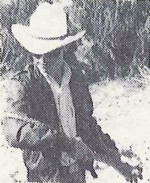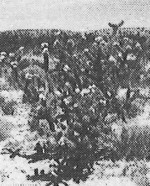Sevilleta
Following the April Coordinating Committee meeting in Albuquerque site representatives set out for the Sevilleta Wildlife Refuge. 75 km south. Added to the Network in September 1988, at 100,000 hectares the Sevilleta is the second-largest of the LTER sites.
The first stop, across the muddy Puerco Rio (Pig River), was dry steppe marked by creosote shrub and dead juniper (from a ‘50s drought) that 18,000 years ago had been a conifer forest. P1 James Gosz provided an overview of the site, and Manual Molles, an introduction to a watershed study of both large-scale climatic variation (including El Niffo effects) and local precipitation on the hydrology and ecology of ephemeral streams. Molles, a climate/hydrology/fluvial ecology specialist, explained his two-fisted approach: high-tech tunelapse video recorders, with low-tech painting of stream channels, pebbles and boulders as a back-up. Thus far he has found that the most flow follows dry winters, and that the zone is moving into a period of frequent returns (four to seven years) of El Niño effects.
Other stops included desert grassland communities of blue and black gram a grass and kangaroo rat mounds, riparian cottonwoods along the Rio Grande, and limestone caves where a USGS paleoecologist from Tucson, AZ, has found human remains and pleistocene material 20,000 to 50,000 years old. A lunch of Jim Gosz’s homebred pork with beans and an array of fruit was served at the foot of the Los Piños Mountains, where mountain lions reportedly feed along the canyon wash at night.
Several species of “critters’ and birds were sighted throughout the day, including a herd of muledeer, a bullsnake, a Gambel’s quail, a pair of burrowing owls and an imported lab-bred kangaroo rat. Flora included Ephedra (mormon tea), four species of cactus, and pinyon pine.
Jornada
The group had dwindled from 30 to 11 for the four-hour drive to the Jornada Experimental Range and New Mexico State University Ranch the following day. The tour was condensed into just a few hours to accommodate departures from El Paso and Albuquerque.
Forty kilometers north of Las Cruces, south of the White Sands Missile Range (site of the first atomic bomb test), co-PI Gary Cunningham directed the group onto the vast 104,166 hectare Range. Research activities at Jornada focus on desertification and the consequent alteration of the water and nitrogen distribution.
Tour stops on the Jomada del Muerto (‘journey of death”— so-called by the unfortunates who attempted to cross it on foot) plan included playa and basin grassland communities and mesquite dunes. One phenomenon observed, coming in such arid ecosystems, was a small cyclonic storm or dust convectur (“dust devil”) that carries seed long distances. The folk explanation offered by guide Bob Parmenter (SEV) was that there were two “jackalopes” fighting and kicking up dust.
Brad Music of the University of New Mexico’s Technology Application Center, described the Desert Winls Project “geomet” station set up two and a half years ago to define the geologic and meteorologic controls on processes—primarily wind erosion and deposition—that shape desert surfaces. The sophisticated instrumentation—a NOAA developed sand flux sensor, soil heat flux sensors, and a Fryrear sandcatcher—measures windblown

 Enlarge this image
Enlarge this image

